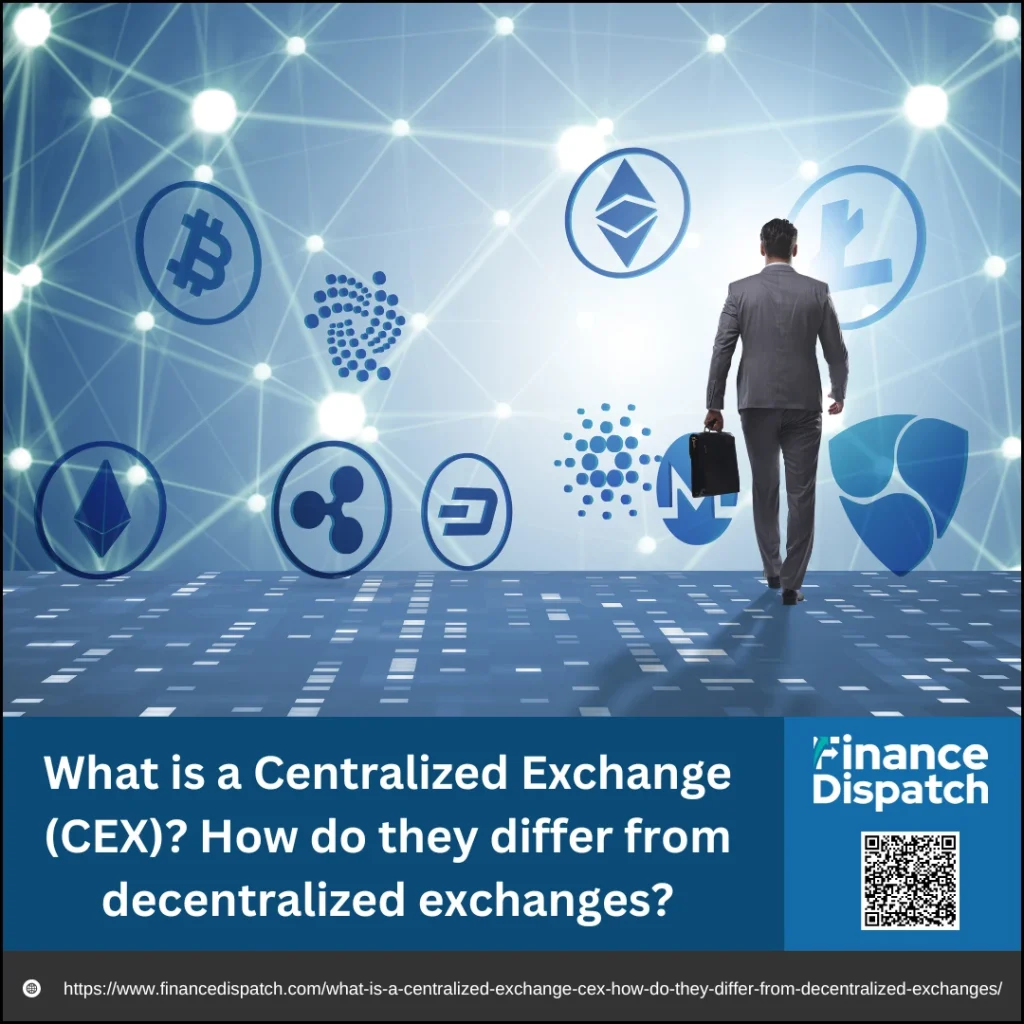Cryptocurrency trading has evolved rapidly, offering traders multiple ways to buy and sell digital assets. Among the most popular options are Centralized Exchanges (CEX) and Decentralized Exchanges (DEX)—two distinct platforms with their own advantages and trade-offs. CEXs, like Binance and Coinbase, function as intermediaries, providing an easy-to-use and regulated environment for crypto trading. In contrast, DEXs, such as Uniswap and PancakeSwap, operate without a central authority, allowing users to trade directly from their wallets while maintaining full control over their funds. Understanding the differences between these two types of exchanges is crucial for choosing the right platform based on your trading style, security preferences, and privacy needs. In this article, we’ll explore how centralized exchanges work, their benefits and drawbacks, and how they compare to decentralized exchanges.
What is a Centralized Exchange (CEX)?
A Centralized Exchange (CEX) is a digital platform that facilitates the buying, selling, and trading of cryptocurrencies by acting as an intermediary between buyers and sellers. These exchanges operate similarly to traditional stock markets, where users deposit funds into the platform, and the exchange executes transactions on their behalf. Examples of well-known CEXs include Binance, Coinbase, and Kraken. Unlike decentralized exchanges, which allow peer-to-peer trading, centralized exchanges hold custody of user funds and manage private keys, providing a user-friendly experience with high liquidity and fast trade execution. However, this convenience comes at the cost of reduced control over assets, as users must trust the exchange to secure their funds and comply with regulations such as Know Your Customer (KYC) and Anti-Money Laundering (AML) policies.
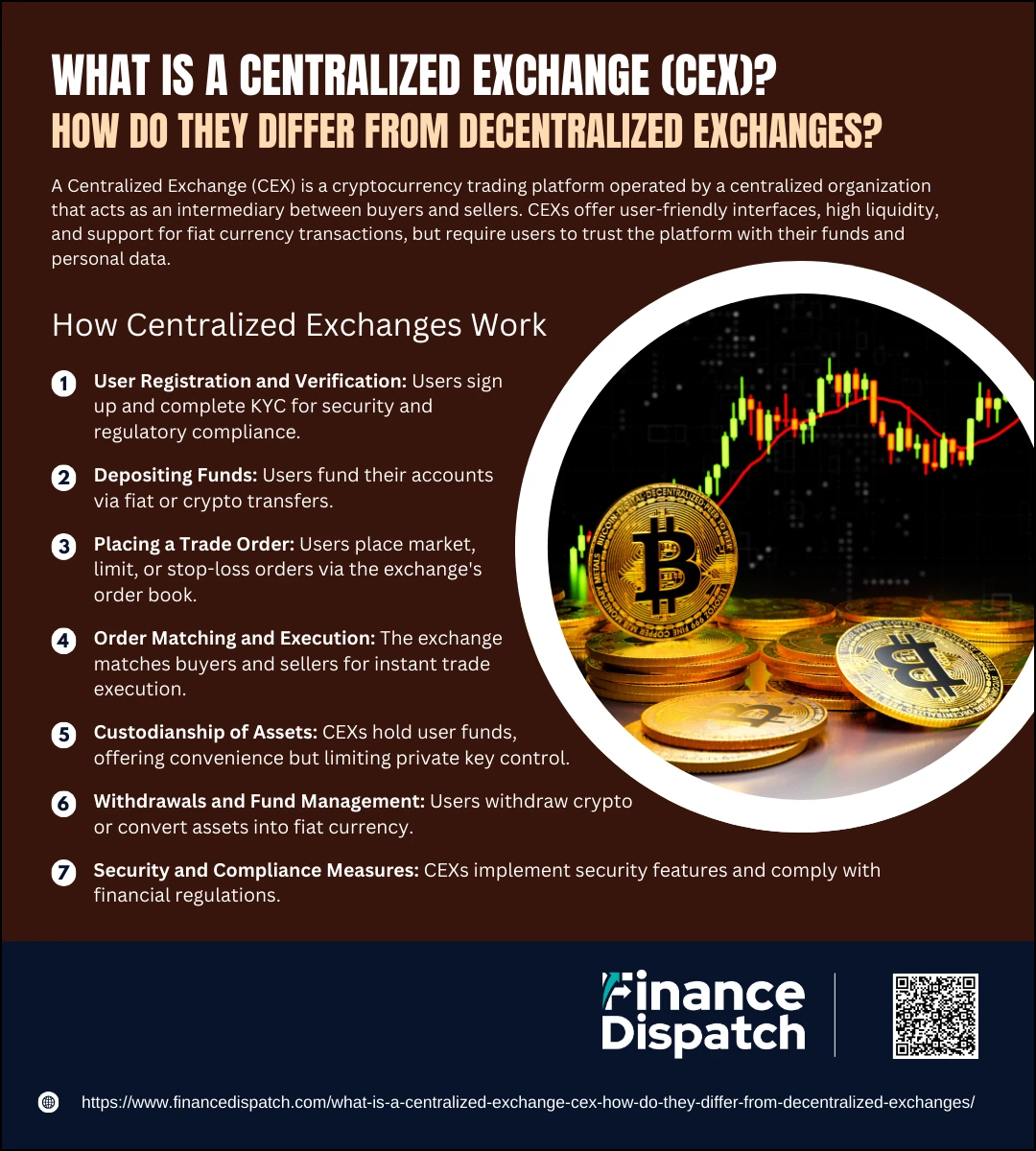 How Centralized Exchanges Work
How Centralized Exchanges Work
A Centralized Exchange (CEX) acts as a middleman in cryptocurrency trading, facilitating transactions between buyers and sellers. These platforms function similarly to traditional financial institutions, managing user funds, executing trades, and providing additional services like fiat deposits and withdrawals. By centralizing operations, they offer higher liquidity, faster trade execution, and customer support, making them an ideal choice for both beginners and professional traders. However, since the exchange controls user funds and private keys, traders must rely on the platform’s security measures and regulatory compliance. Below is a step-by-step breakdown of how a centralized exchange operates.
1. User Registration and Verification
Users create an account by providing an email, password, and other personal details. Most exchanges require Know Your Customer (KYC) verification, where users submit identity documents to comply with regulations and prevent fraud.
2. Depositing Funds
After verification, users deposit funds into the exchange. This can be done using fiat currency (such as USD, EUR) via bank transfer, credit card, or payment services or by transferring cryptocurrencies from an external wallet.
3. Placing a Trade Order
Users can place different types of orders, including market orders (instant trades at current price), limit orders (trades at a specified price), and stop-loss orders (to minimize losses). The exchange processes these transactions using an order book system that matches buyers and sellers.
4. Order Matching and Execution
The exchange’s system identifies a matching order in real-time. Once a buy and sell order meet at a common price, the trade is executed instantly. Some exchanges use market makers to ensure liquidity and maintain efficient order execution.
5. Custodianship of Assets
Unlike decentralized exchanges, a CEX holds custody of user funds in centralized wallets. This makes trading faster and more convenient but also means that users do not control their private keys. Security measures like cold storage and two-factor authentication (2FA) help protect assets from hacks.
6. Withdrawals and Fund Management
Users can withdraw funds by transferring crypto to an external wallet or converting digital assets into fiat currency and sending them to a linked bank account. Some CEXs charge withdrawal fees based on network congestion and the amount withdrawn.
7. Security and Compliance Measures
To safeguard user funds, centralized exchanges implement encryption, multi-signature wallets, and security audits. They also comply with financial regulations, ensuring transparency through AML (Anti-Money Laundering) policies, government registrations, and legal audits.
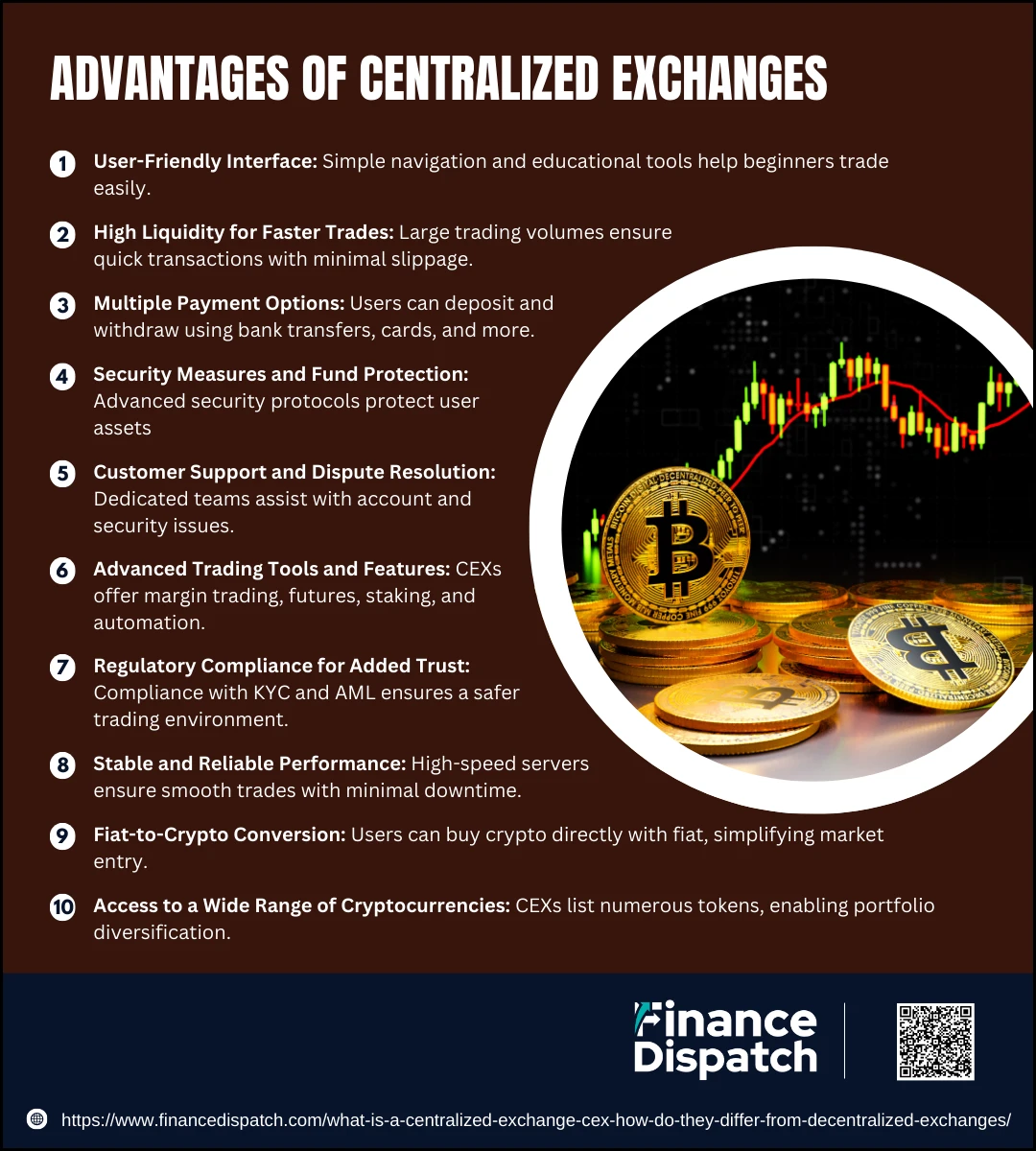 Advantages of Centralized Exchanges
Advantages of Centralized Exchanges
Centralized Exchanges (CEXs) have become the go-to platforms for cryptocurrency trading due to their ease of use, high liquidity, and security measures. Unlike decentralized exchanges, CEXs handle all aspects of trading, from order matching to fund management, making them ideal for beginners and experienced traders alike. They also offer customer support, regulatory compliance, and additional trading features, making the trading experience smoother and more reliable. Below are some key advantages of using a centralized exchange.
1. User-Friendly Interface
Centralized exchanges provide intuitive dashboards and easy navigation, making it simple for users to trade cryptocurrencies without technical expertise. Most platforms also offer mobile apps, real-time price tracking, and educational resources to help users get started.
2. High Liquidity for Faster Trades
CEXs have a large number of active traders and institutional investors, ensuring high liquidity. This allows users to execute trades quickly at stable prices, reducing slippage and making it easier to buy or sell large amounts of cryptocurrency.
3. Multiple Payment Options
Unlike decentralized exchanges, CEXs allow users to deposit and withdraw fiat currency using bank transfers, credit/debit cards, and third-party payment services. This makes it easier for beginners to enter the crypto market without needing prior knowledge of blockchain transactions.
4. Security Measures and Fund Protection
Top centralized exchanges implement advanced security measures such as cold storage wallets, two-factor authentication (2FA), anti-phishing protections, and encryption protocols. Some exchanges also provide insurance policies to cover user funds in case of a breach.
5. Customer Support and Dispute Resolution
Unlike DEXs, where users are on their own, CEXs offer dedicated customer service teams to assist with account issues, fund recovery, and security concerns. Many exchanges provide live chat, email, and phone support to help users resolve problems quickly.
6. Advanced Trading Tools and Features
CEXs offer more than just basic buying and selling. Users can access margin trading, futures contracts, staking, lending, and yield farming, giving them multiple ways to maximize profits. Many platforms also offer automated trading bots and API integrations for professional traders.
7. Regulatory Compliance for Added Trust
Major centralized exchanges operate under legal frameworks and comply with regulations such as Know Your Customer (KYC) and Anti-Money Laundering (AML) policies. This provides a level of safety and accountability, ensuring a more secure trading environment.
8. Stable and Reliable Performance
Unlike decentralized exchanges that may suffer from network congestion or smart contract vulnerabilities, CEXs operate on high-speed servers that ensure smooth trade execution, minimal downtime, and real-time price updates.
9. Fiat-to-Crypto Conversion
CEXs act as on-ramps for new crypto investors, allowing them to purchase cryptocurrencies directly with fiat money. This is a crucial feature for beginners who want a simple way to enter the crypto market without needing prior blockchain experience.
10. Access to a Wide Range of Cryptocurrencies
Most CEXs support hundreds of cryptocurrencies and trading pairs, allowing users to diversify their portfolios. They also list new and emerging tokens after rigorous vetting, ensuring users have access to secure and legitimate projects.
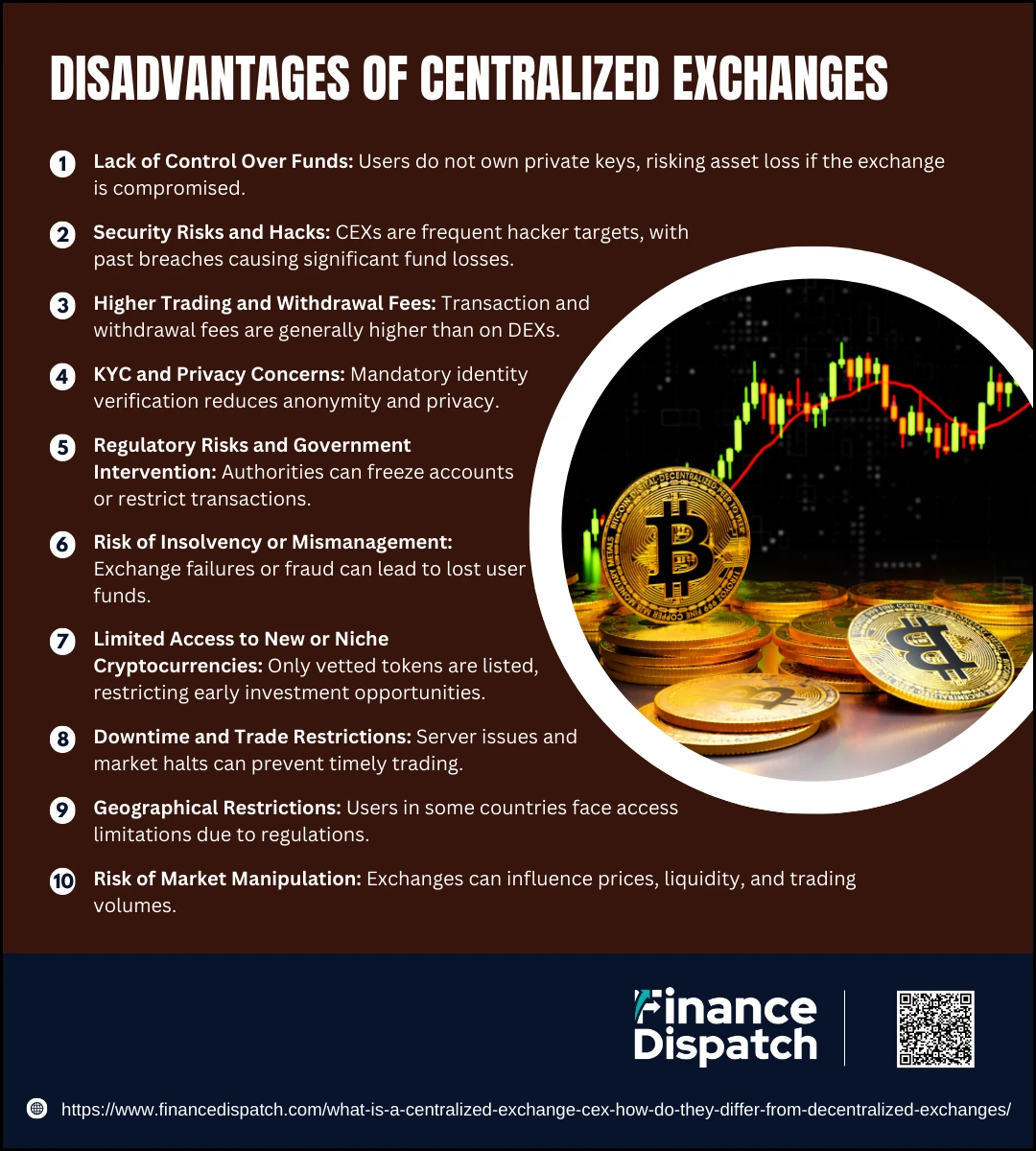 Disadvantages of Centralized Exchanges
Disadvantages of Centralized Exchanges
While Centralized Exchanges (CEXs) offer convenience, high liquidity, and security features, they also come with certain drawbacks. Since they act as intermediaries, users do not have full control over their funds, making them vulnerable to security breaches, regulatory actions, and operational failures. Additionally, higher fees and privacy concerns may discourage some traders. Below are some key disadvantages of using a centralized exchange.
1. Lack of Control Over Funds
When using a CEX, users must store their funds on the platform, which means they do not own their private keys. This contradicts the crypto principle of “Not your keys, not your crypto.” If the exchange is compromised, users risk losing their assets.
2. Security Risks and Hacks
CEXs are prime targets for hackers because they store large amounts of user funds in centralized wallets. Over the years, several major exchanges, such as Mt. Gox and FTX, have been hacked, leading to millions in lost customer funds.
3. Higher Trading and Withdrawal Fees
Most centralized exchanges charge transaction fees, deposit fees, and withdrawal fees, which can add up over time. Compared to Decentralized Exchanges (DEXs), CEXs generally have higher trading fees and additional costs for moving funds off the platform.
4. KYC and Privacy Concerns
CEXs require users to submit personal information and undergo Know Your Customer (KYC) verification. While this improves regulatory compliance, it reduces anonymity and privacy, which is a key appeal of cryptocurrency for many users.
5. Regulatory Risks and Government Intervention
Since centralized exchanges operate under financial regulations, they can be forced to freeze accounts, limit withdrawals, or comply with government orders. Some exchanges have banned users from certain regions due to regulatory restrictions.
6. Risk of Insolvency or Mismanagement
If a centralized exchange faces bankruptcy or internal fraud, users may lose access to their funds. The collapse of FTX in 2022 highlighted the risks of trusting a centralized entity with customer deposits.
7. Limited Access to New or Niche Cryptocurrencies
Unlike DEXs, which allow listing of new and experimental tokens, centralized exchanges only list vetted cryptocurrencies. This means users might miss out on early investment opportunities in emerging projects.
8. Downtime and Trade Restrictions
High traffic and server issues can cause temporary outages, slowing down trading activities. Some exchanges also limit withdrawals or halt trading during market crashes, preventing users from accessing their funds when they need them most.
9. Geographical Restrictions
Many CEXs have location-based restrictions, making it difficult for users in certain countries to access services or withdraw funds. Regulatory policies can force exchanges to block users from specific regions.
10. Risk of Market Manipulation
Since centralized exchanges control the order book and liquidity, there is potential for price manipulation, front-running, and insider trading. Some platforms have been accused of artificially inflating trading volumes to attract more users.
What is a Decentralized Exchange (DEX)?
A Decentralized Exchange (DEX) is a cryptocurrency trading platform that operates without a central authority, allowing users to trade directly from their own wallets. Unlike Centralized Exchanges (CEXs), which act as intermediaries and hold user funds, DEXs enable peer-to-peer (P2P) transactions through smart contracts on blockchain networks. Popular DEXs like Uniswap, PancakeSwap, and SushiSwap use Automated Market Maker (AMM) protocols to facilitate trades, eliminating the need for traditional order books. This decentralized structure provides greater privacy, security, and control over funds, as users retain ownership of their private keys. However, DEXs often require technical knowledge, have lower liquidity, and rely on blockchain network speeds for transaction processing. Despite these challenges, they are favored by those who prioritize decentralization, anonymity, and unrestricted access to a wide range of cryptocurrencies.
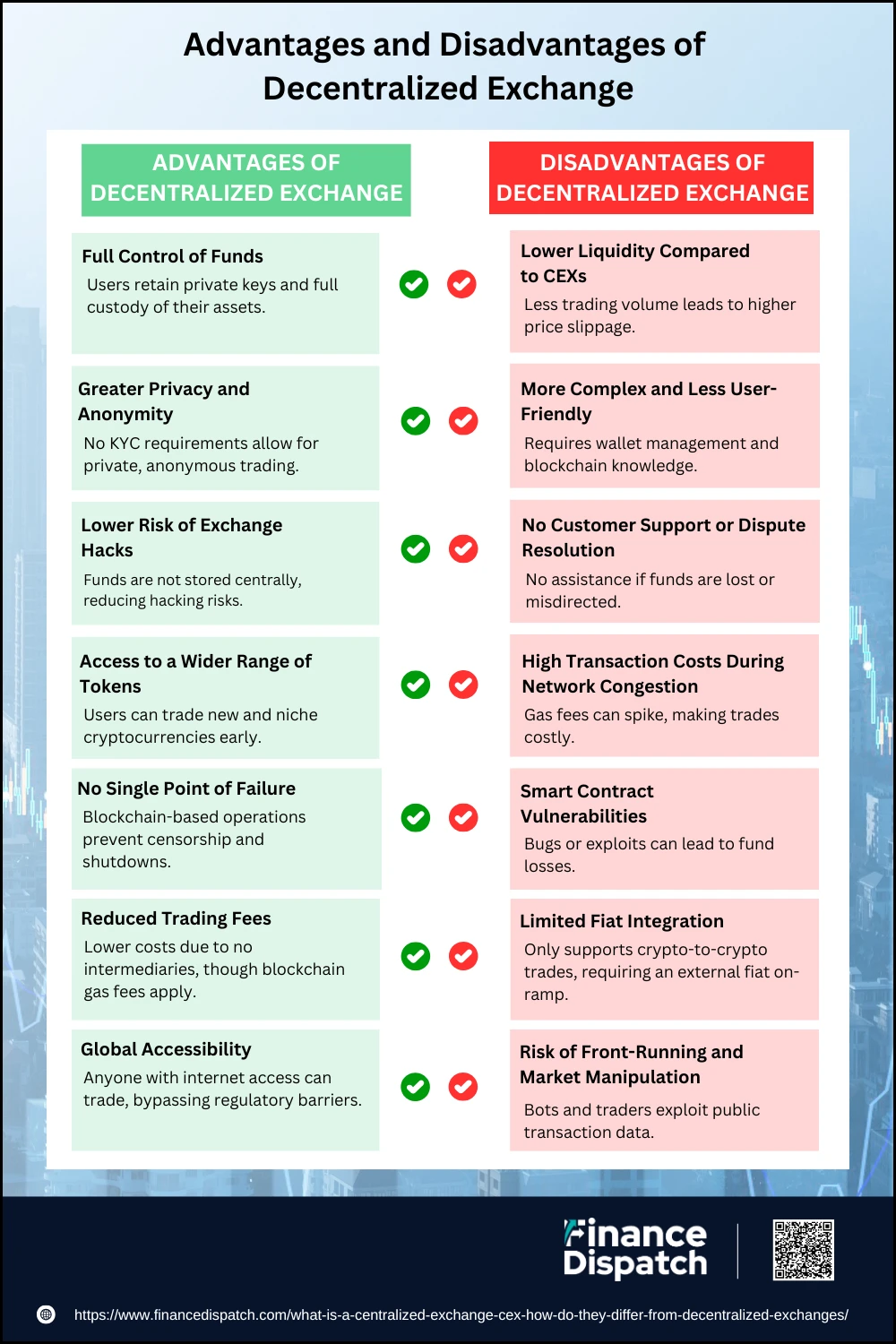 Advantages and Disadvantages of Decentralized Exchange
Advantages and Disadvantages of Decentralized Exchange
Decentralized Exchanges (DEXs) are reshaping the way cryptocurrency trading works by removing intermediaries and enabling peer-to-peer transactions. Unlike Centralized Exchanges (CEXs), which hold user funds and manage transactions on private servers, DEXs operate on blockchain-based smart contracts, allowing users to trade directly from their wallets. This offers greater security, financial sovereignty, and access to new digital assets. However, DEXs also come with challenges, such as lower liquidity, lack of customer support, and a steep learning curve. Below is a detailed look at the advantages and disadvantages of using a decentralized exchange.
Advantages of Decentralized Exchange (DEX)
1. Full Control of Funds
One of the main benefits of using a DEX is that users retain full custody of their assets. Since private keys remain with the user, they do not have to rely on an exchange to store or manage their funds. This eliminates the risk of losing assets due to exchange hacks, mismanagement, or regulatory shutdowns.
2. Greater Privacy and Anonymity
Unlike CEXs, which require Know Your Customer (KYC) verification, most DEXs allow users to trade without submitting personal information. This is especially beneficial for traders who prioritize financial privacy and want to avoid identity tracking.
3. Lower Risk of Exchange Hacks
Since DEXs do not store user funds on centralized servers, they are less attractive targets for hackers. In contrast, CEXs store billions of dollars in user funds, making them vulnerable to massive cyberattacks. DEXs reduce systemic risks by distributing transactions across a blockchain network.
4. Access to a Wider Range of Tokens
DEXs offer access to a vast selection of cryptocurrencies, including new and niche tokens that are not yet listed on major centralized exchanges. This allows traders to participate in early-stage projects before they gain mainstream adoption.
5. No Single Point of Failure
Since DEXs are powered by blockchain technology, they do not rely on a single central authority to operate. Even if one node goes down, the exchange remains active, making it highly resistant to censorship and government shutdowns.
6. Reduced Trading Fees
Many DEXs have lower trading fees compared to CEXs because they do not require third-party intermediaries to process transactions. However, users must still pay blockchain gas fees, which fluctuate based on network congestion.
7. Global Accessibility
DEXs enable anyone with an internet connection and a crypto wallet to trade, regardless of their location or regulatory restrictions. This removes barriers to entry for individuals in countries with limited access to traditional financial systems.
Disadvantages of Decentralized Exchange (DEX)
1. Lower Liquidity Compared to CEXs
DEXs generally have fewer active traders and lower trading volumes, which can lead to higher price slippage (a difference between expected and actual trade prices). This makes executing large trades more difficult compared to high-liquidity CEXs.
2. More Complex and Less User-Friendly
DEXs require users to connect an external wallet, manage private keys, and understand gas fees, making them more complex for beginners. In contrast, CEXs offer simple interfaces, fiat deposit options, and one-click trading.
3. No Customer Support or Dispute Resolution
Since DEXs operate without intermediaries, there is no customer service team to assist users with issues. If a user sends funds to the wrong address or loses access to their private keys, their assets cannot be recovered.
4. High Transaction Costs During Network Congestion
DEXs rely on blockchain networks like Ethereum or Binance Smart Chain, where users must pay gas fees for every transaction. During peak periods, gas fees can become very expensive, making small trades less profitable.
5. Smart Contract Vulnerabilities
DEXs are powered by smart contracts, which are not foolproof. If a contract contains a bug or security loophole, hackers can exploit it to drain liquidity pools or steal funds. Even well-audited smart contracts are not 100% immune to risks.
6. Limited Fiat Integration
Unlike CEXs, which allow users to buy crypto with fiat currency (USD, EUR, etc.), DEXs only support crypto-to-crypto trading. This means new users must first buy cryptocurrency from a CEX or a fiat on-ramp before using a DEX.
7. Risk of Front-Running and Market Manipulation
Since blockchain transactions are publicly visible, bots and advanced traders can engage in front-running (where they place trades ahead of large orders to profit from price changes). This can lead to unfair trading advantages and price manipulation on DEXs.
Key Differences between CEX and DEX
While both Centralized Exchanges (CEXs) and Decentralized Exchanges (DEXs) facilitate cryptocurrency trading, they operate on fundamentally different models. CEXs act as intermediaries, providing a user-friendly and regulated environment with high liquidity, but they control user funds and require identity verification. DEXs, on the other hand, enable direct peer-to-peer trading through blockchain-based smart contracts, offering greater privacy and self-custody of assets but with lower liquidity and higher complexity. The choice between a CEX and a DEX depends on factors like security, ease of use, trading speed, and regulatory preferences. Below is a comparison of the key differences between these two exchange types.
| Feature | Centralized Exchange (CEX) | Decentralized Exchange (DEX) |
| Control of Funds | Exchange holds user funds (custodial) | Users retain control of their private keys (non-custodial) |
| Privacy | Requires KYC and identity verification | No KYC required, fully anonymous trading |
| Liquidity | High liquidity, fast order execution | Lower liquidity, price slippage may occur |
| Ease of Use | Beginner-friendly, intuitive UI | Requires technical knowledge to operate |
| Security | Higher risk of hacks due to centralization | More secure if users safeguard their private keys |
| Customer Support | Dedicated support available | No customer support; users are responsible for transactions |
| Trading Speed | Instant trades via internal servers | Dependent on blockchain network speed |
| Fees | Platform fees for trading, deposits, and withdrawals | Lower platform fees but blockchain gas fees apply |
| Regulation | Heavily regulated, subject to government laws | Mostly unregulated, operates autonomously on blockchain |
| Token Availability | Limited to vetted tokens listed by the exchange | Access to a wider range of new and niche tokens |
| Fiat Integration | Supports fiat-to-crypto trading | Crypto-to-crypto trading only, no fiat support |
| Risk of Platform Failure | Can freeze accounts, face insolvency, or shut down | Cannot be shut down as it runs on smart contracts |
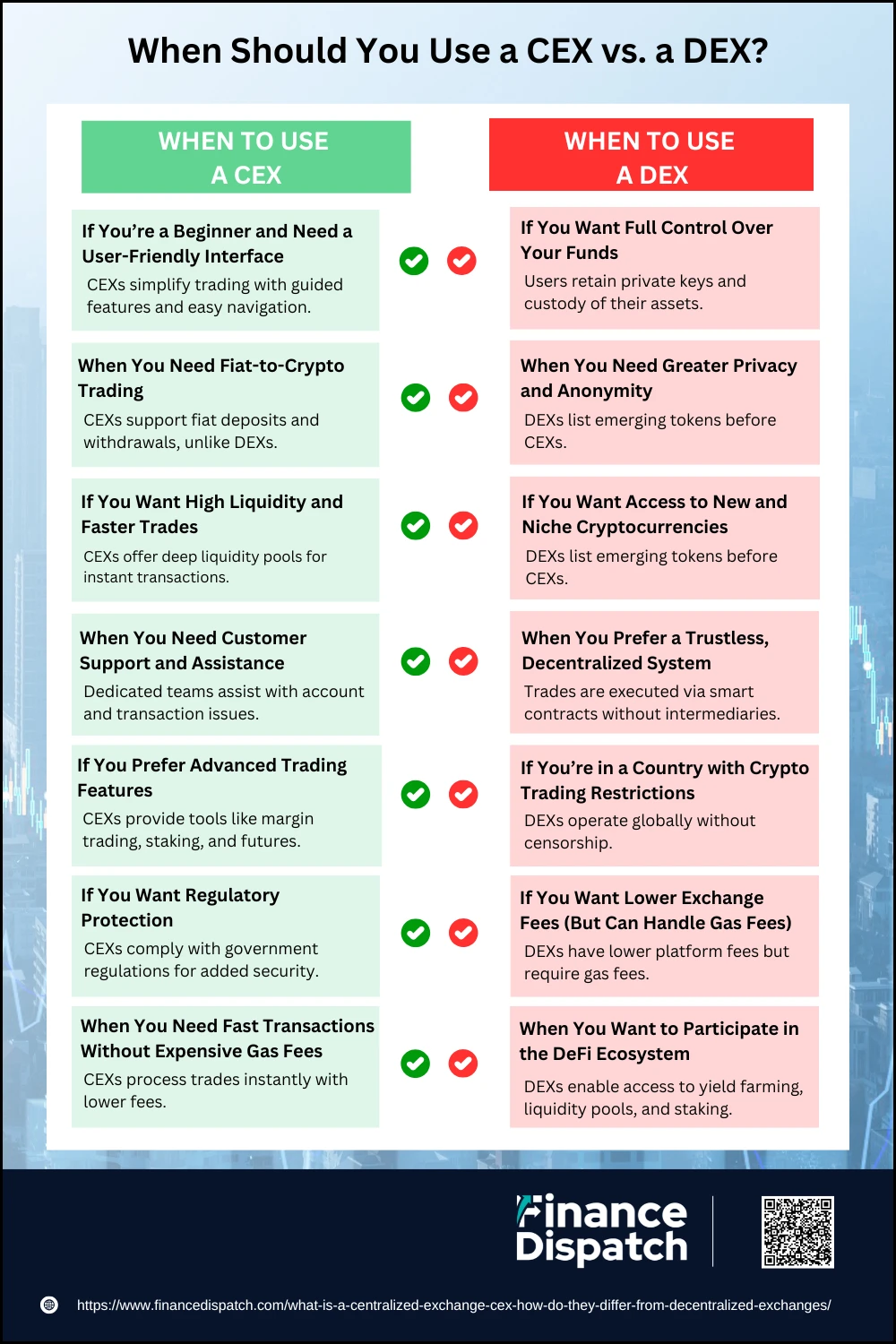 When Should You Use a CEX vs. a DEX?
When Should You Use a CEX vs. a DEX?
Choosing between a Centralized Exchange (CEX) and a Decentralized Exchange (DEX) depends on your trading goals, security preferences, and experience level. CEXs function similarly to traditional financial institutions, offering high liquidity, fast transactions, fiat support, and customer service. These exchanges are ideal for beginners and large-scale traders who prioritize ease of use. On the other hand, DEXs provide complete financial autonomy, greater privacy, and access to a wider range of tokens, making them attractive to users who prefer decentralization and control over their assets. Below, we break down when you should use each type of exchange.
When to Use a CEX
1. If You’re a Beginner and Need a User-Friendly Interface
For newcomers to cryptocurrency trading, CEXs provide an intuitive experience with easy navigation, real-time price tracking, and guided trading features. Unlike DEXs, which require users to understand wallets, private keys, and gas fees, CEXs simplify the process by managing these aspects on behalf of users.
2. When You Need Fiat-to-Crypto Trading
CEXs allow users to deposit and withdraw fiat currencies (USD, EUR, GBP) via credit cards, bank transfers, and other payment gateways. This makes it much easier for users to convert their traditional money into cryptocurrencies without the need for a third-party service. DEXs, in contrast, do not support fiat transactions.
3. If You Want High Liquidity and Faster Trades
Centralized exchanges have large trading volumes and deep liquidity pools, allowing users to execute trades instantly at stable market prices. In a DEX, low liquidity can result in price slippage, where a user ends up paying more (or receiving less) than expected for a trade.
4. When You Need Customer Support and Assistance
CEXs offer dedicated customer service teams via live chat, email, and sometimes phone support. If you encounter issues such as a forgotten password, a failed transaction, or an account lockout, a support team can assist you. DEXs, however, are completely autonomous, meaning users are responsible for troubleshooting their own issues.
5. If You Prefer Advanced Trading Features
CEXs provide advanced tools like margin trading, futures contracts, staking, lending, and stop-loss orders. These features enhance trading strategies and provide opportunities for passive income, making CEXs a better choice for traders who need more than just basic swaps.
6. If You Want Regulatory Protection
Many centralized exchanges operate under government regulations and comply with Know Your Customer (KYC) and Anti-Money Laundering (AML) policies. This provides users with an added level of security and accountability. DEXs, in contrast, are largely unregulated, meaning there is little recourse if an issue arises.
7. When You Need Fast Transactions Without Expensive Gas Fees
CEX transactions occur on internal servers, ensuring instant processing and lower fees. In contrast, DEX transactions happen on a blockchain, requiring network gas fees, which can fluctuate based on congestion and become costly.
When to Use a DEX
1. If You Want Full Control Over Your Funds
In a DEX, users trade directly from their wallets, retaining ownership of their private keys. This eliminates the risk of losing funds due to exchange hacks, regulatory crackdowns, or internal fraud—common risks associated with centralized exchanges.
2. When You Need Greater Privacy and Anonymity
DEXs do not require identity verification (KYC), meaning users can trade anonymously. For those concerned about data privacy, using a DEX avoids submitting personal information to a centralized entity.
3. If You Want Access to New and Niche Cryptocurrencies
Many new cryptocurrency projects launch exclusively on DEXs before being listed on CEXs. This makes DEXs the best place to discover new tokens early and take advantage of investment opportunities before they go mainstream.
4. When You Prefer a Trustless, Decentralized System
DEXs use smart contracts to facilitate trades, meaning there is no need to trust a central authority. This decentralized structure ensures that no single entity controls users’ funds or manipulates trading activities.
5. If You’re in a Country with Crypto Trading Restrictions
In some countries, government regulations restrict access to centralized exchanges or require them to freeze accounts. DEXs operate globally and are resistant to censorship, allowing users to trade freely regardless of location.
6. If You Want Lower Exchange Fees (But Can Handle Gas Fees)
DEXs typically have lower platform fees compared to CEXs since there are no intermediaries. However, users must still pay gas fees for blockchain transactions, which can fluctuate based on network congestion.
7. When You Want to Participate in the DeFi Ecosystem
DEXs offer access to decentralized finance (DeFi) applications, such as yield farming, liquidity pools, and staking. These DeFi services provide opportunities for passive income and greater interaction with blockchain technology.
Conclusion
Both Centralized Exchanges (CEXs) and Decentralized Exchanges (DEXs) play a crucial role in the cryptocurrency ecosystem, offering different benefits depending on a trader’s needs. CEXs provide high liquidity, ease of use, customer support, and fiat integration, making them an ideal choice for beginners and professional traders looking for fast and efficient transactions. On the other hand, DEXs prioritize financial autonomy, privacy, and decentralization, giving users full control over their funds while eliminating intermediaries. While CEXs offer convenience at the cost of custodianship and regulatory oversight, DEXs provide security and anonymity but require more technical knowledge and come with lower liquidity. For many traders, using both platforms strategically—leveraging CEXs for speed and liquidity while utilizing DEXs for privacy and access to emerging tokens— is the best approach. Ultimately, the choice between a CEX and a DEX depends on individual preferences, trading experience, and the level of control one desires over their crypto assets.



